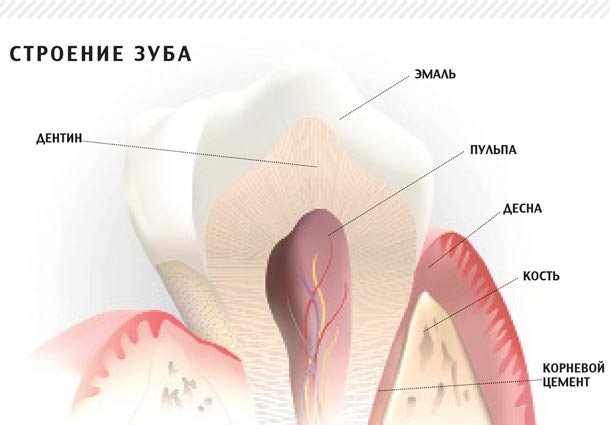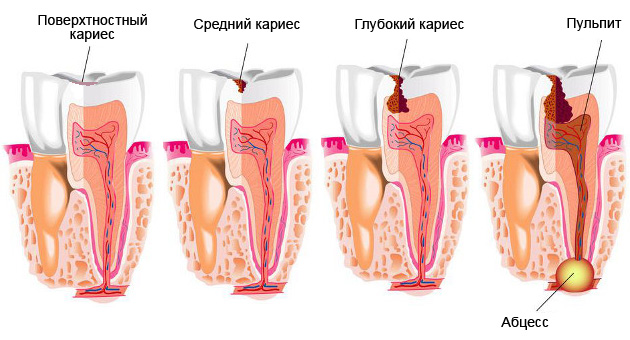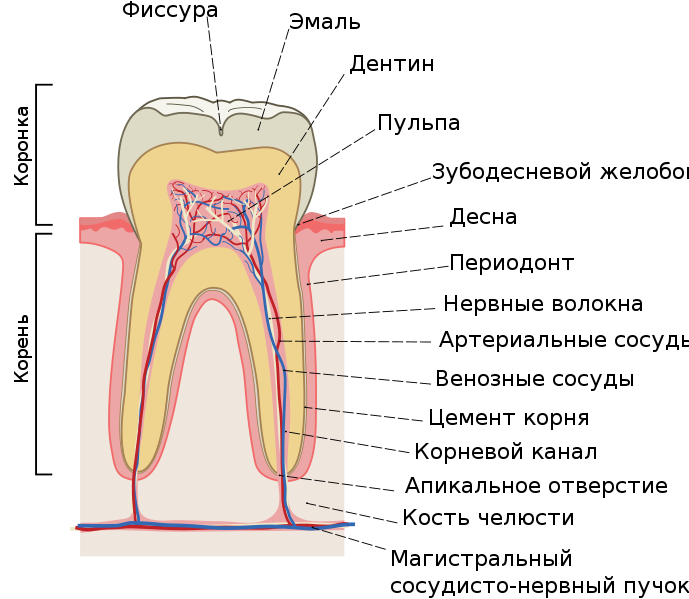Why does humanity suffer from tooth decay, and can we fight this?

Caries is a complex, slowly flowing pathological process in the solid tissues of the tooth, which develops as a result of the complex effect of unfavorable external and internal factors. In the initial stage of development, caries is characterized by focal demineralization of the inorganic part of the enamel and destruction of its organic matrix. In the end, this leads to the destruction of the hard tissues of the tooth with the formation of cavity in the dentin, and in the absence of treatment - to the occurrence of inflammatory complications from the pulp and periodontal.
Caries is an infection that affects almost all the inhabitants of our planet today. According to epidemiologists, even in the Middle Ages the prevalence of caries in Europe was three times less than today's. The reason for the victorious march of a dental illness lies primarily in what we eat.
The fact that the teeth attacked a persistent and difficult to destroy infection, partly to blame humanity itself. Today, most dentists stick to the version that the cariogenic bacterium Streptococcus mutans migrated into the oral cavity from the stomach 10-15 thousand years ago, when the first tribes of our ancestors switched to agriculture and cattle breeding, abandoning the hunt, and began to consume less protein (meat) And more carbohydrates (cereals, vegetables and dairy products). Surprisingly, the infectious nature of caries has been reliably established less than half a century ago.
Bacteria responsible for the development of the carious process were identified at the beginning of the 20th century. But, in addition to the initiator of the initial stage of caries, S. mutans, among the "provocateurs", later scientists also discovered several other types of streptococci and lactobacilli that continue the process, and, in addition, the species of actinomycetes responsible for caries of the tooth root. The fact that the cause of an unpleasant disease is streptococci, it is quite logical. Microbes of this kind have been present for thousands of years in the digestive system of humans and animals, usually without causing any harm.
To maintain their own lives, streptococci use carbohydrates of our food, decomposing them with a record speed compared with other bacteria and leaving after that alcohols, aldehydes or acids. With the advent of large cities and public catering, the carious bacterium seized more and more mouths, and the triumph of streptococcus reached after the industrial revolution, when refined sugar, lemonades and other foods with a high sucrose content - ideal for fast fermentation of carbohydrates - became cheap and affordable. It was then that dental plaque turned for cariogenic microbes into an ideal environment for parasitism.
Mechanism of destruction

To understand how caries appear, you first need to know that the tooth enamel is about 95% composed of the mineral - calcium hydroxyapatite Ca10 (PO4) 6 (OH) 2. Its hexagonal crystals combine in prisms and provide durability of bones and teeth. Enamel of only one incisor contains about 5 million mineral prisms.
Like all hydroxyl ("alkaline") minerals, hydroxyapatite is destroyed by the action of acids. This is due to a violation of the notorious acid-base balance, known to everyone for advertising chewing gum. When an acid enters the mouth, for example with a sip of wine, our body tries to neutralize it, and calcium from the enamel migrates into the saliva. And without calcium, mineral prisms crumble like card-shaped houses. If the process is repeated, the acids attack the dentin under the enamel. Then a carious cavity appears in the tooth - a cavity.
Especially "terrible" simple organic acids, such as acetic, lactic and citric. Therefore, when we drink wine or eat an orange, the enamel of our teeth is doomed to partial destruction. But acids appear in the mouth and without oranges. Streptococcus plaque feed on the carbohydrates that we eat, and the by-product of their fermentation is just aggressive acids. The simpler the carbohydrate, the faster the acid is formed from it. And this means that the more often we eat simple carbohydrates (glucose, fructose, sucrose), the more caries progress.
Approximately the mechanism of development of this disease was described by the American dentist Willoughby Miller at the end of the XIX century, calling it a chemical-parasitic theory. This means that, on the one hand, the appearance of caries is a chemical process, but without microbial parasites, it would not be so large-scale or even neutralized at all. According to Edith Kuzmina, head of the department of caries prevention at MGSU, three reasons are responsible for the appearance of caries: plaque with bacteria, carbohydrate food and weak resistance of tooth enamel.
This means that there can be only three ways to fight tooth decay: eat as few simple sugars (easily fermented carbohydrates), make the tooth enamel more resistant to destruction and, finally, rid the teeth of the plaque in which streptococci are hidden.
Bitter sweet truth
Of course, people knew about it for a long time, but people proved the role of diet in the appearance of caries only when in numerous independent experiments it was established that streptococci are present in plaque and in people free of caries. The first step in proving the "guilt" of sugar was made by Danish professor Frederick von der Feer from the Royal Dental College in Aarhus. In 1970, von der Feer conducted an experiment in which a group of volunteers with a good state of tooth enamel completely ruled out oral hygiene - they did not clean or rinse their teeth after eating.
Half of them also several times a day rinsed the mouth with a 50% solution of sucrose. The lack of hygiene increased the number of bacteria in the plaque, but when comparing the teeth of those who rinsed the mouth with a sweet solution, more obvious signs of caries were found with the control group - the demineralization of the enamel and the appearance of spots on it.
If earlier, for example, in the not so distant XVIII century, sugar was an expensive product and appeared in the diet of not everyone, now, according to dental polls, most people in Russia and many other countries eat sweet daily. As Edit Kuzmin notes, it is not so much the amount of sweet eaten at a time that is important, but the frequency of its consumption.
Ideally, dentists advise eating sweet as little as possible and replacing fermented sugars - glucose, sucrose and fructose - with sorbitol, mannitol and xylitol. These polyhydric alcohols have a sweet taste and are often used as sugar substitutes (for example, with diabetes), and caries streptococci simply can not be disposed of. Natural xylitol is found in strawberries and carrots. And if you can not give up the sweet one, then it is better not to eat it "alone", but, together with other food, it reduces cariogenicity. The same acid apples, for example, require a copious saliva separation, and it dilutes and, with an alkaline reaction, partially neutralizes the acid formed in the mouth after fermentation of sucrose and glucose.
Two-faced fluoride

If the first way to combat tooth decay - to give up the sweet tooth - is not suitable for everyone, then it is much easier to make tooth enamel more resistant to acids. Fluorination is still the only globally recognized and most effective way to strengthen enamel.
For the first time, massively add fluorides to milk for the prevention of tooth decay in schools and kindergartens in Switzerland in 1953. After 60 years, 95% of the toothpastes in the world contain fluorides. If you read the composition of your toothpaste, you will most likely find in it sodium fluoride, monofluorophosphate or aminofluoride. Or maybe there will be a few fluorides. The mechanism by which all these substances help to protect teeth from caries is very simple. Fluorine ions are introduced into the crystal lattice of mineral enamel prisms, after which its solubility in acids decreases.
On the other hand, it is because of fluorides that toothpaste is recommended to be used in quantities as large as a pea, rather than sausages that are as long as the entire bristles of a toothbrush, as shown in television commercials. The main reason for this - the danger of fluorosis, or supersaturation of enamel fluoride.
The insidiousness of fluorine lies in the fact that if it is too much, it turns the hydroxyapatite of the enamel into another, more fragile mineral, and the teeth begin to literally crumble. In this case, fluorides can enter the body not only with toothpaste - it is enough just to inhale them. For example, among people living near active volcanoes and plants producing hydrofluoric acid, fluorosis occurs three times more often: volcanic ash and waste products contain fluorides. For the first time this effect of "overdose" fluoride was told also by the Roman poet Mark Martial, describing the teeth of Alexander the Great concubine as "speckled."
To keep your teeth and avoid their destruction from excess fluoride, it's enough just to follow the "pea rule" and do not brush your teeth too often - two to three times a day is enough. Fluoridation has fierce opponents who claim that toothpaste and fluoride-enriched milk, which can be bought in Russia, cause a whole bunch of dangerous diseases down to malignant tumors. But such statements are not supported by any reliable data. Yes, fluoride and its compounds are really toxic substances.
But here the whole matter is in concentration: even Paracelsus (Philippe Aureol Theophrastus Bombast von Hohenheim), the great physician and alchemist of the Renaissance, formulated an aphorism that has not lost its relevance over the past five centuries: "Everything is poison and everything is medicine; One or the other does only a dose of it. " To poison yourself with fluoride, you need to literally eat a few tubes of toothpaste every day. As for milk with sodium fluoride, its daily norm is a glass (200 ml), as indicated on the package.
However, tooth pastes with fluorides have an alternative. First of all, paste without fluorine, strengthening enamel due to calcium or whole mineral molecules - artificial hydroxyapatite, intended for children, often swallowing paste, and people living in the risk zone.
The caries vaccine
To invent a vaccine against caries, forcing the body to kill pathogenic streptococci, is the cherished dream of many scientists. The closest thing to getting rid of mankind from sounds of a drill came from Chinese researchers from the Institute of Virology in Wuhan. In 2011, they announced a successful test in rats of a combined DNA vaccine. The essence of it is that in addition to the DNA of the streptococcus itself it also contains the nucleic acid of another bacterium, Salmonella. On salmonella immunity reacts more actively, straightening at the same time and with cariogenic streptococcus.
But even if the inoculation against caries and appears in the arsenal of dentists, it is unlikely that we will be able to forget about the seals and dentures. As one of the world's leading epidemiologists, Daniel Smith of the Boston Foresight Institute, explains, the vaccine will be really effective only if it is vaccinated to children between the ages of one and two - when the first milk teeth appear, but the plaque - the community of bacteria - does not have time to form .
The caries vaccine has one more weakness. Even if she manages to overcome one type of streptococcus causing the first signs of the disease, other types of bacteria that connect to the destruction of the tooth at different stages, may well be re-qualified as initiators. Therefore, dentists call caries an insidious infection, which can and should be combated with while traditional ways: follow the diet and visit the dentist regularly. In fact, unlike sharks, who during the course of their lives can renew several thousand teeth, we, people, lose precious teeth forever.
The "harmful" hormone
Scientists found that the prevalence of caries among men is usually lower than among women. This is due to the direct relationship between the level of estrogens in the blood and the microbial microflora of the oral cavity. The first direct correlations in experiments with rats were obtained in the middle of the last century at the University of Indiana. Researchers have noticed that the rate of caries increases with the increase in the level of estrogens in males, as well as in females, both conventional and ovariectomized (deprived of ovaries). At the same time, the level of male hormones - androgens - did not show any significant effect on the condition of the teeth. Dozens of studies have confirmed the relationship between the level of female hormones and the likelihood of developing caries. While the exact mechanism of the effect of estrogens on dental health has not been studied, it is believed that saliva contains estrogen-sensitive immunoreactive proteins that regulate the amount of cariogenic microbes in the mouth.
Via www.popmech.ru


Comments
When commenting on, remember that the content and tone of your message can hurt the feelings of real people, show respect and tolerance to your interlocutors even if you do not share their opinion, your behavior in the conditions of freedom of expression and anonymity provided by the Internet, changes Not only virtual, but also the real world. All comments are hidden from the index, spam is controlled.